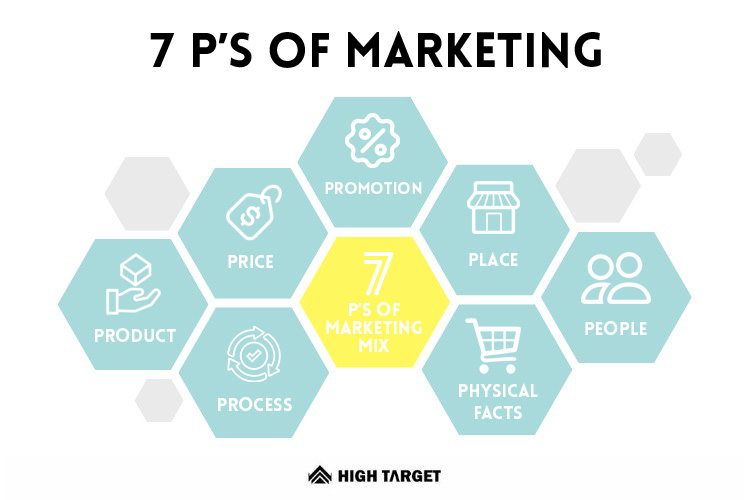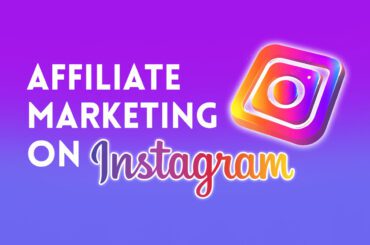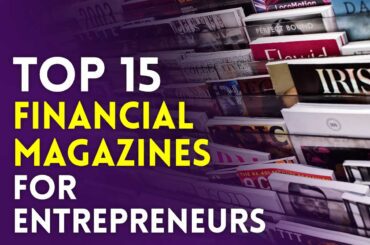Use the 7 Ps, or recognized marketing methods, in whatever way you see fit to please clients in your target market. You can influence the 7 Ps, but they will also be affected by your internal and external marketing settings. Using a “tactical marketing mix” refers to the practice of combining these many marketing strategies in order to better serve the requirements and desires of your target audience. Marketing is about more than just advertising. The 7 p’s of marketing is a simple framework for planning and executing marketing programs, consisting of 4 Ps (product, price, placement, promotion) and 3 Ps (people, process, place).
Planning and analyzing a marketing strategy is a continual procedure. Students in almost all introductory marketing classes learn the “marketing mix” as the first premise The 7 p’s of marketing analysis. Product, price, promotion, and location were formerly thought of as the “4 Ps” of the marketing mix. Recently, a fifth “P” People was introduced for service-based enterprises.
More recently, packaging and positioning have been incorporated as new subcategories of strategic marketing study. There are many resources available in the marketing mix. However, we recommend an essay written by Brian Tracy. You may read the whole thing again down below. “The 7 p’s of marketing” is a formula that serves as a quick review of the basics–the 7 key elements of marketing.

Product
Is there anything you sell now that, if you knew then what you know now, you wouldn’t release again? Is your product or service significantly better than the alternatives on the market? If so, please explain it. If not, do you think you could master anything else? Is there really a need for this product or service in the existing market?
The characteristics, advantages, and benefits that your clients will get as a result of purchasing your products or services are collectively referred to as the “product.” Consider the characteristics and advantages that consumers value most when promoting your product, such as (but not limited to) aesthetics, durability, ease of maintenance, and availability of spare parts and add-ons. Insights gained via R&D may guide the creation of brand-new offerings for your company.
Price
The 7 p’s of marketing are a useful framework for both learning and teaching the fundamentals of marketing. Price is the second P in the formula. Make it a practice to check the pricing of your goods and services often to make sure they are still reasonable given the state of the market. Reduced pricing may be necessary on occasion. Price increases could be warranted on occasion. Many businesses have come to the conclusion that certain goods or services aren’t worth the cost of developing them. Even if some clients are lost due to price increases, the business will still make money on each transaction. You may find this useful if it turns out to be true.
What this means is considering how your clients will respond to your price plan before implementing any changes. What are your clients willing to pay? What markup do you need to cover expenses? What are your profit margins, and how will you get paid? Seasonal pricing and discounts are options to explore if you want to draw in clients and keep your edge in the market.
Promotion
Advertising, sales strategies, promotions, and direct marketing are all examples of these activities, all of which are designed to raise consumer awareness of your company and its offerings. These are often known as promotional strategies.
What you’re doing in terms of advertising and selling will fail at some point. There will be instances when you know exactly why it stopped functioning and other times when you have no idea. In any scenario, you’ll need to come up with fresh sales, marketing, and advertising tactics, services, and strategies after your current ones run out of steam.
Place
Your physical location is where your goods and services are on display, manufactured, sold, and distributed. Making ensuring your items can be easily accessed by clients and that they can locate you is crucial. Visual merchandising and store layout may help you stand out from the crowd and attract more customers than the competitors.
Although the location may not be as directly relevant to your marketing efforts as it could be for a retail establishment, it is still an essential aspect of any firm. Your clients might have time-sensitive delivery requirements or preferences for items made in the vicinity. Finding a good spot to set up shop is a crucial promotional strategy for any new business.
One’s product has broad potential for distribution channels. Some businesses use a technique called “direct selling,” in which a salesperson goes directly to a potential customer. In certain cases, sales are made using telemarketing. Some businesses only do business through mail-order catalogs. Some of them are sold in stores, while others are sold at trade fairs. Some of these items are sold in conjunction with others of a similar kind. Manufacturers’ reps and distributors are used by certain businesses. In practice, many businesses use many of these strategies simultaneously.
People
People are the employees and salesmen (including yourself) that make up your company. Customers’ perceptions of your brand are enhanced when you go above and beyond to meet their needs. As a result, your current clientele may become your best source of new business via word-of-mouth. In order to get an edge over the competition, it is important to hire the proper people, provide them with opportunities to learn and grow in their roles and keep the excellent employees you’ve already hired.
Even while many company owners and entrepreneurs spend considerable time and energy planning out their marketing strategy and marketing mix, they often fail to realize that each plan must be carried out by a specific person in accordance with established protocols. Everything else pales in comparison to the success or failure of your organization based on your ability to pick, acquire, employ, and retain the right people to get the job done.
Process
Delivering your goods and services to the end-user is what we call “the process.” Being “easy to do business with” also has a role. The ability to consistently provide a high level of service to consumers is dependent on the existence of well-defined processes. Study the norms, practices, and processes of business.
Physical Facts
What clients see when they connect with your company is what is known as “physical proof.” Everything from the storefront’s exterior and interior design to the product’s packaging and branding is a part of the customer experience. The appearance and behavior of your employees might likewise be considered physical proof.
The 7 p’s marketing strategy
Depending on one’s line of work, one’s intended clientele, and one’s inventory, every business has its own unique set of guidelines by which it operates. But there is one approach that can be used by marketers in every industry. Here we have the marketing mix. So as not to dwell excessively on minor points, let’s quickly go over what the marketing mix entails: Product, Place, Price, and Promotion are the classic four The 7 p’s of marketing. In addition to those four components, the expanded marketing mix also includes the following three: Things, People, and Methods.
Professor and scholar Neil H. Borden is credited with developing the idea of the marketing mix, which builds on James Culliton’s observation that company leaders are essentially chefs. Components are several elements and methods of advertising. Professor and author Jerome McCarthy subsequently honed the marketing mix to include the four P’s: product, place, price, and promotion. McCarthy discussed the “4 Ps” in his 1960s book, Basic Marketing: A Managerial Approach.
It’s possible that you think that the four Ps cover pretty much all there is to business and marketing. They do a good job of covering the basics, but in modern business, issues like customer service and satisfaction have taken center stage. After the success of the 4Ps, contemporary academics Booms and Bitner identified three more important components in 1981: physical evidence, people, and process. Because of this, we now have the 7 Ps of the marketing mix.
Once you learn about the three parts that make up the expanded framework of the marketing mix, you’ll see how they make a difference. Businesses thrive or fail based on the quality of their people. People are essential to marketing because, without them, there would be no one to sell to or serve.
Skimming prices is to start with a high price for your goods and then lower it over time. Using a pricing strategy that is either slightly higher or cheaper than the competition is an example of competition-based pricing. Pricing strategies that appeal to customers looking for deals are called “economy pricing.”
To put a high price on a product is to use premium pricing. Before labeling anything as “luxury,” it’s important to make sure it really lives up to those standards. Value-based pricing is a pricing approach in which the price of a product or service is established in accordance with the market’s perceived value of that good or service. You may avoid making a loss by charging more than your product costs to produce by using a pricing strategy called “cost-plus.”
Where can people find you online? Shop anywhere you like: online or in-person. How does the season impact your business? You should adjust your approach accordingly if swimwear is your sole product line or vice versa if you exclusively offer Christmas decorations.
Which personality trait best describes your brand? The tone and style of your advertising might be influenced by the kind of identity you have. Do people get the impression that you are approachable, serious, funny, genuine, and exciting? How do your rivals market their businesses? You may learn a lot about effective marketing tactics by observing how the competition advertises and responds to those observations, as well as by studying the broader market for trends. Frequently completing a SWOT analysis will allow you to thoroughly examine your strategies and the strategies of your competitors.
Despite the fact that this crucial component is included, tangible proof also includes the presence of your brand as a whole. Consider your online presence, logo, storefront design, product packaging, email receipts, and social media pages. These items provide the consumer with the tangible proof they need to have faith in your company’s viability, reliability, and legitimacy.
Scams, bogus corporations, and shady establishments abound in both the virtual and brick-and-mortar worlds. Customers need to believe that they can trust you before they will make a purchase, stick with your business, or even recommend it to others.
Any company serious about succeeding in today’s consumer-driven marketplace must prioritize providing outstanding customer service. Dave Chaffey, a digital strategist, opines that the personal connection is what drives consumers to make purchases directly from other people. Just because individuals prefer to buy from a real person in person doesn’t mean they have to. Campaigns that center on the customer experience have the potential to be as compelling as a top salesman if marketers take the time to personalize and tweak their approaches.
One way to keep from damaging your company’s image is to ignore consumer concerns. If managed properly, this will aid in your rehabilitation and assist you in protecting your brand’s image in the future.
The smoother and more individualized your procedures, the more satisfied your consumers will be. There won’t be any complaints about your goods if it’s high quality. However, there are other aspects of the process that must be accounted for in your marketing plan. This is probably the moment that you’ll start hearing complaints. Common causes of customer dissatisfaction include shipment delays, hidden fees, ineffective communication, and a lack of follow-up.
Keeping an eye on internet reviews is a great way to cut down on customer complaints and fine-tune your approach. When clients express dissatisfaction, it’s time to rethink and adjust your procedures. A brand’s success or failure may often be determined by user feedback, particularly online. Therefore, the buyer’s trip as a whole must be smooth and productive.
Conclusion
Having a solid framework to work from allows marketers to plan and execute campaigns that attract and keep their most important consumers. Marketers that want to develop a plan that gets them where they want to go and helps their businesses grow may use the 7Ps of the marketing mix as an organized checklist. Use Hurree to monitor key performance indicators in real-time and see how they’re changing. Learn how to revolutionize your company’s reporting with the help of cross-platform dashboards by giving Hurree a try right now.












